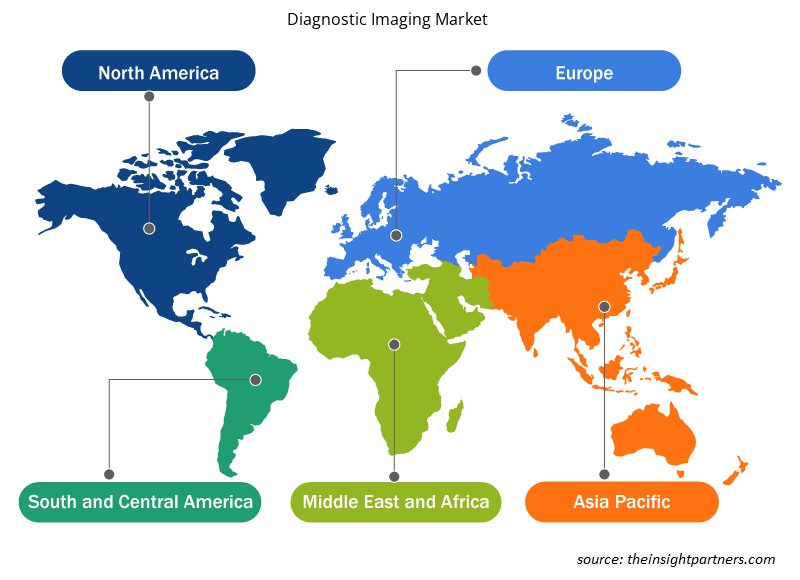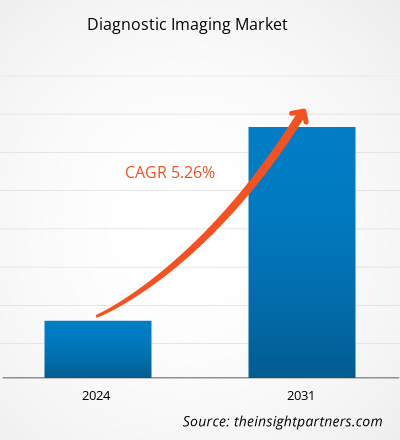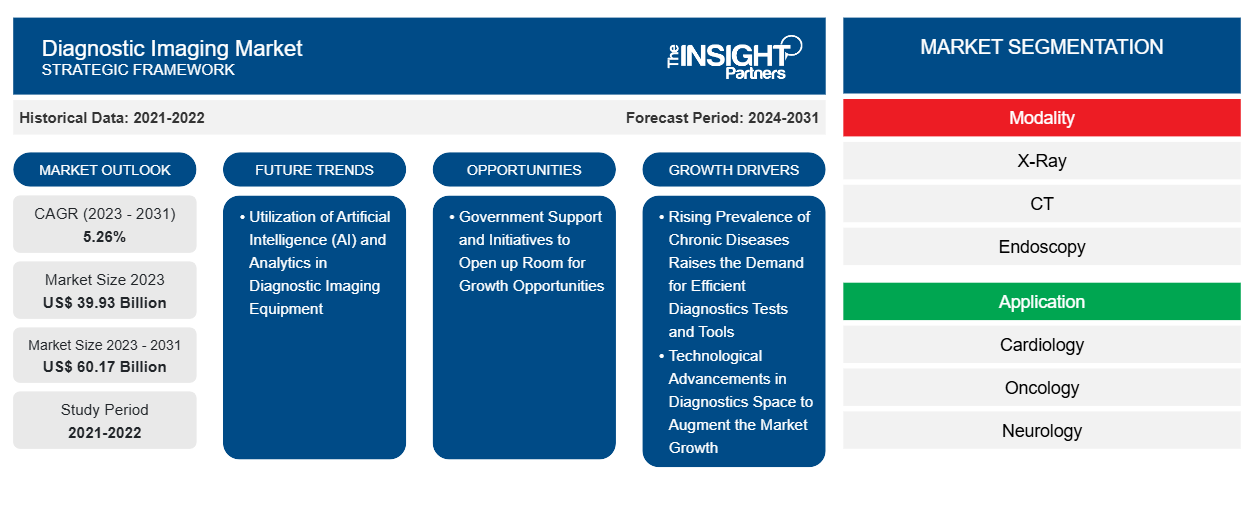診断用画像市場の規模は、2023年の399.3億米ドルから2031年には601.7億米ドルに達すると予測されています。市場は2023年から2031年の間に5.26%のCAGRを記録すると予想されています。診断用画像機器における人工知能(AI)と分析の利用の増加は、市場の主要なトレンドであり続けると思われます。
診断画像市場分析
画像診断とは、人体のさまざまな組織や臓器を視覚的に表現し、病気や怪我の原因を特定し、診断を確定し、治療への反応を監視するためのさまざまな技術を指します。X 線、コンピューター断層撮影 (CT)、陽電子放出断層撮影 (PET)、磁気共鳴画像 (MRI)、単一光子放出コンピューター断層撮影 (SPECT)、デジタルマンモグラフィー、診断用超音波などのさまざまな機械や技術により、体内の構造や活動の画像を生成できます。多くの画像診断テストは非侵襲的で、シンプルで痛みがありません。ただし、長時間機械の中にじっとしている必要があるものもあり、多少の不快感を感じることがあります。さらに、特定のテストでは少量の放射線被ばくを伴います。慢性疾患の有病率の増加は、市場の主要な成長促進要因です。さらに、医療診断の分野における新しい開発は、予測期間中の市場の成長に貢献します。
診断画像市場の概要
2023年には、アジア太平洋地域が世界の診断画像市場で最も高いCAGRで成長すると予想されています。アジア太平洋地域の診断画像市場は、中国、日本、インドなどの国の発展により大幅に成長すると予想されています。2023年9月に国立医学図書館(NLM)に掲載された記事によると、人口10万人あたりのCTスキャナーの数は高知県が最も多く、病院のCTスキャナーの数が最も多かったのは東京都でした。したがって、アジア太平洋地域の市場は、いくつかのアジア諸国における国際的プレーヤーからの投資の増加によって牽引されています。したがって、この地域は、予測期間中に診断画像市場のプレーヤーが成長する大きな可能性を秘めています。
要件に合わせてレポートをカスタマイズする
このレポートの一部、国レベルの分析、Excelデータパックなど、あらゆるレポートを無料でカスタマイズできます。また、スタートアップや大学向けのお得なオファーや割引もご利用いただけます。
-
このレポートの主要な市場動向を入手してください。この無料サンプルには、市場動向から見積もりや予測に至るまでのデータ分析が含まれます。
診断画像市場の推進要因と機会
診断画像技術の進歩が市場を有利に導く
世界保健機関(WHO)が強調しているように、画像診断は急速に進歩しており、さまざまな病気の診断と治療をサポートすることで医療において重要な役割を果たしています。画像診断サービスには、最終的に治療への反応を導き出すために、多くの病状の経過を確認、評価、文書化することが含まれます。2021年10月にAdventHealth大学が発表した記事によると、近年、デジタルラジオグラフィーには多くの進歩がありました。これには、AI支援X線解釈、デュアルエネルギーイメージング、コンピューター支援診断、トモシンセシス、自動画像ステッチング、デジタルモバイルラジオグラフィーが含まれます。これらの進歩により、画像品質が向上し、最終的に患者ケアが強化され、患者の転帰が改善されました。さらに、デジタルラジオグラフィーを使用すると、再撮影の必要性が減り、放射線被ばくが低減します。
病気の診断のための画像技術のこのような進歩は、診断用画像市場の成長を促進します。
政府の取り組みが成長の機会をもたらす
政府は、世界中で医療機器の購入、価格設定、流通において重要な役割を果たしています。政府は医療インフラの開発に向けてさまざまな取り組みを行っており、新しい医療施設の開設に対する資金提供を通じて、安全で費用対効果の高い医療製品の提供に重点を置いています。たとえば、英国では、国民保健サービスが費用対効果の高い方法で患者の満たされていない医療ニーズに対応し、国の経済成長を促進することを目標としています。さらに、カナダ政府は、2020年に国内の民間資金が不足していたため、患者1人あたりスキャン1回につき1,400米ドルを病院に支払いました。
さらに、WHOや国連国際児童緊急基金(UNICEF)などの非営利規制機関は、メーカーと協力して、遠隔地での診断サービスの改善を目的とした効果的なソリューションを開発しています。さらに、これらの組織は、患者の安全性に重点を置いた画像技術の使用と管理に関するトレーニングプログラムを提供しています。たとえば、2022年2月、Siemens Healthineersは、サハラ以南のアフリカでの診断技術に対する医療へのアクセス改善を支援するためにUNICEFと提携しました。
上述のような要因は、診断画像市場の成長を促進する有利な機会を提供する役割を果たしています。
診断画像市場レポートのセグメンテーション分析
診断画像市場分析の導出に貢献した主要なセグメントは、モダリティ、アプリケーション、およびエンドユーザーです。
- 診断用画像市場は、モダリティに基づいて、X線、CT、内視鏡検査、超音波、MRI、核医学画像診断、マンモグラフィーなどに区分されています。ELISA検査セグメントは、2023年に最大の市場シェアを占めました。
- 用途別に見ると、市場は心臓病学、腫瘍学、神経学、整形外科、消化器学、産婦人科学、その他に分類されています。鳥インフルエンザ分野は2023年に最大の市場シェアを占めました。
- 市場は、エンドユーザーに基づいて、病院と診療所、診断画像センター、外来手術センター、その他に分類されています。病院と診療所のセグメントは、2023年に最大の市場シェアを占めました。
地域別診断画像市場シェア分析
診断画像市場レポートの地理的範囲は、主に北米、アジア太平洋、ヨーロッパ、中東およびアフリカ、南米および中米の 5 つの地域に分かれています。
北米は、次世代シーケンシング市場で最大の市場シェアを占めています。北米の診断用画像市場は、米国、カナダ、メキシコに基づいて分析されています。米国は、2023年に北米の診断用画像市場を支配すると予測されています。米国では、革新的な画像診断法の発売と規制当局による承認により、診断用画像の利用率が高くなっています。たとえば、2021年9月、FDAはコンピューター断層撮影(CT)画像診断における最初の重要な新しい技術進歩の承認を発表しました。このデバイスは、患者の体を通過する個々のX線をすべて測定するために、光子計数検出器の新しいCT技術を利用しています。FDAはまた、2021年にシーメンスが製造した新しい診断用画像診断装置「NAEOTOM Alpha」を審査しました。このような画像診断法の技術進歩により、米国での診断用画像の普及が加速しています。
さらに、米国の人口が高齢化するにつれて、高齢者によく見られる多くの慢性的な健康状態や疾患の診断、検出、治療のための診断用画像技術の需要が急速に高まると予想されています。
したがって、北米市場の成長は、この地域における診断画像技術の需要の増加によるものです。
診断用画像市場の地域別分析
予測期間を通じて診断画像市場に影響を与える地域的な傾向と要因は、Insight Partners のアナリストによって徹底的に説明されています。このセクションでは、北米、ヨーロッパ、アジア太平洋、中東およびアフリカ、南米および中米にわたる診断画像市場のセグメントと地理についても説明します。

- 診断画像市場の地域別データを入手
診断画像市場レポートの範囲
| レポート属性 | 詳細 |
|---|---|
| 2023年の市場規模 | 399.3億米ドル |
| 2031年までの市場規模 | 601.7億米ドル |
| 世界のCAGR(2023年~2031年) | 5.26% |
| 履歴データ | 2021-2022 |
| 予測期間 | 2024-2031 |
| 対象セグメント |
モダリティ別
|
| 対象地域と国 |
北米
|
| 市場リーダーと主要企業プロフィール |
|
診断画像市場のプレーヤー密度:ビジネスダイナミクスへの影響を理解する
診断用画像市場は、消費者の嗜好の変化、技術の進歩、製品の利点に対する認識の高まりなどの要因により、エンドユーザーの需要が高まり、急速に成長しています。需要が高まるにつれて、企業は提供内容を拡大し、消費者のニーズを満たすために革新し、新たなトレンドを活用し、市場の成長をさらに促進しています。
市場プレーヤー密度とは、特定の市場または業界内で活動している企業または会社の分布を指します。これは、特定の市場スペースに、その市場規模または総市場価値に対してどれだけの競合相手 (市場プレーヤー) が存在するかを示します。
診断画像市場で事業を展開している主要企業は次のとおりです。
- ゼネラル・エレクトリック・カンパニー
- シーメンス ヘルシナーズ
- フィリップスNV
- カールストルツ SE & Co. KG
- 富士フイルムホールディングス株式会社
- キヤノン株式会社
免責事項:上記の企業は、特定の順序でランク付けされていません。

- 診断画像市場のトップキープレーヤーの概要を入手
診断画像市場のニュースと最近の動向
診断用画像市場は、主要な企業出版物、協会データ、データベースを含む一次調査と二次調査から定性的および定量的データを収集することによって評価されます。診断用画像市場の動向のいくつかを以下に示します。
- Wipro GE Healthcare は、次世代の Revolution Aspire CT (コンピューター断層撮影) スキャナーの発売を発表しました。Revolution Aspire は、インドで新たに開設された Wipro GE Medical Devices Manufacturing 工場で、「Atmanirbhar Bharat」イニシアチブに沿って設計および製造された高度な画像ソリューションです。CT システムには、病気や異常を診断する際の臨床的信頼性を向上させるために、より高度な画像インテリジェンスが搭載されています。(出典: GE HealthCare、プレスリリース、2022 年)
- GEヘルスケアは、よりパーソナライズされた医療の実現に役立つ生体内腫瘍学および神経学バイオマーカーの大手イノベーターであるZionexaを買収しました。再発性または転移性乳がん患者の治療選択に役立つエストロゲン受容体(ER)陽性病変の検出のための生検の補助として使用されるFDA承認のPETイメージング剤であるCerianna(フルオロエストラジオールF-18)は、同社によって拡大されています。(出典:GEヘルスケア、プレスリリース、2021年)
診断画像市場レポートの対象範囲と成果物
「診断画像市場の規模と予測(2021〜2031年)」レポートでは、以下の分野をカバーする市場の詳細な分析を提供しています。
- 診断用画像市場の規模と予測は、対象範囲に含まれるすべての主要市場セグメントについて、世界、地域、国レベルで示されています。
- 診断用画像市場の動向、および推進要因、制約、主要な機会などの市場動向
- 詳細なPEST/ポーターの5つの力とSWOT分析
- 主要な市場動向、世界および地域の枠組み、主要なプレーヤー、規制、最近の市場動向を網羅した診断画像市場分析
- 市場集中、ヒートマップ分析、主要プレーヤー、診断画像市場における最近の動向を網羅した業界の状況と競争分析
- 詳細な企業プロフィール
- 過去2年間の分析、基準年、CAGRによる予測(7年間)
- PEST分析とSWOT分析
- 市場規模価値/数量 - 世界、地域、国
- 業界と競争環境
- Excel データセット
最新レポート
お客様の声
購入理由
- 情報に基づいた意思決定
- 市場動向の理解
- 競合分析
- 顧客インサイト
- 市場予測
- リスク軽減
- 戦略計画
- 投資の正当性
- 新興市場の特定
- マーケティング戦略の強化
- 業務効率の向上
- 規制動向への対応























 無料サンプルを入手 - 診断画像市場
無料サンプルを入手 - 診断画像市場